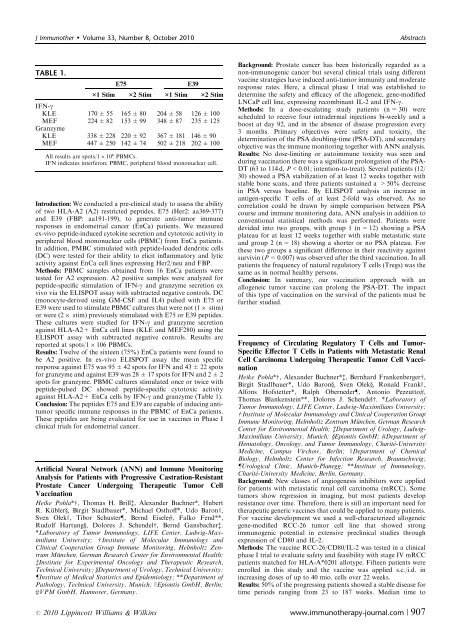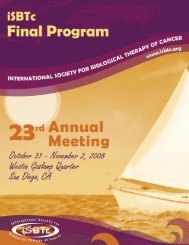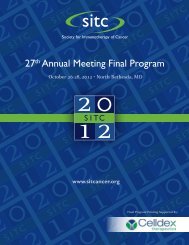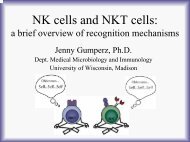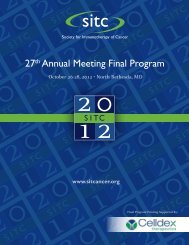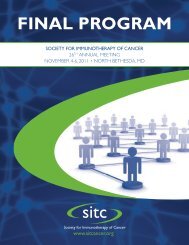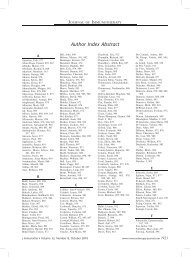Abstracts for the 25th Annual Scientific Meeting of the International ...
Abstracts for the 25th Annual Scientific Meeting of the International ...
Abstracts for the 25th Annual Scientific Meeting of the International ...
You also want an ePaper? Increase the reach of your titles
YUMPU automatically turns print PDFs into web optimized ePapers that Google loves.
J Immuno<strong>the</strong>r Volume 33, Number 8, October 2010<br />
<strong>Abstracts</strong><br />
TABLE 1.<br />
E75<br />
E39<br />
¾1 Stim ¾2 Stim ¾1 Stim ¾2 Stim<br />
IFN-g<br />
KLE 170 ± 55 165 ± 80 204 ± 58 126 ± 100<br />
MEF 224 ± 82 153 ± 99 348 ± 87 235 ± 125<br />
Granzyme<br />
KLE 338 ± 228 220 ± 92 367 ± 181 146 ± 90<br />
MEF 447 ± 250 142 ± 74 502 ± 218 202 ± 100<br />
All results are spots/1 10 6 PBMCs.<br />
IFN indicates interferon; PBMC, peripheral blood mononuclear cell.<br />
Introduction: We conducted a pre-clinical study to assess <strong>the</strong> ability<br />
<strong>of</strong> two HLA-A2 (A2) restricted peptides, E75 (Her2: aa369-377)<br />
and E39 (FBP: aa191-199), to generate anti-tumor immune<br />
responses in endometrial cancer (EnCa) patients. We measured<br />
ex-vivo peptide-induced cytokine secretion and cytotoxic activity in<br />
peripheral blood mononuclear cells (PBMC) from EnCa patients.<br />
In addition, PMBC stimulated with peptide-loaded dendritic cells<br />
(DC) were tested <strong>for</strong> <strong>the</strong>ir ability to elicit inflammatory and lytic<br />
activity against EnCa cell lines expressing Her2/neu and FBP.<br />
Methods: PBMC samples obtained from 16 EnCa patients were<br />
tested <strong>for</strong> A2 expression. A2 positive samples were analyzed <strong>for</strong><br />
peptide-specific stimulation <strong>of</strong> IFN-g and granzyme secretion ex<br />
vivo via <strong>the</strong> ELISPOT assay with subtracted negative controls. DC<br />
(monocyte-derived using GM-CSF and IL4) pulsed with E75 or<br />
E39 were used to stimulate PBMC cultures that were not (1 stim)<br />
or were (2 stim) previously stimulated with E75 or E39 peptides.<br />
These cultures were studied <strong>for</strong> IFN-g and granzyme secretion<br />
against HLA-A2+ EnCa cell lines (KLE and MEF280) using <strong>the</strong><br />
ELISPOT assay with subtracted negative controls. Results are<br />
reported at spots/1 106 PBMCs.<br />
Results: Twelve <strong>of</strong> <strong>the</strong> sixteen (75%) EnCa patients were found to<br />
be A2 positive. In ex-vivo ELISPOT assay <strong>the</strong> mean specific<br />
response against E75 was 95 ± 42 spots <strong>for</strong> IFN and 43 ± 22 spots<br />
<strong>for</strong> granzyme and against E39 was 28 ± 17 spots <strong>for</strong> IFN and 2 ± 2<br />
spots <strong>for</strong> granzyme. PBMC cultures stimulated once or twice with<br />
peptide-pulsed DC showed peptide-specific cytotoxic activity<br />
against HLA-A2+ EnCa cells by IFN-g and granzyme (Table 1).<br />
Conclusion: The peptides E75 and E39 are capable <strong>of</strong> inducing antitumor<br />
specific immune responses in <strong>the</strong> PBMC <strong>of</strong> EnCa patients.<br />
These peptides are being evaluated <strong>for</strong> use in vaccines in Phase I<br />
clinical trials <strong>for</strong> endometrial cancer.<br />
Artificial Neural Network (ANN) and Immune Monitoring<br />
Analysis <strong>for</strong> Patients with Progressive Castration-Resistant<br />
Prostate Cancer Undergoing Therapeutic Tumor Cell<br />
Vaccination<br />
Heike Pohla*w, Thomas H. Brillz, Alexander Buchner*, Hubert<br />
R. Ku¨ blery, Birgit Stadlbauer*, Michael Osth<strong>of</strong>f*, Udo BaronJ,<br />
Sven OlekJ, Tibor Schusterz, Bernd Eisele#, Falko Fend**,<br />
Rudolf Hartungy, Dolores J. Schendelw, Bernd Gansbacherz.<br />
*Laboratory <strong>of</strong> Tumor Immunology, LIFE Center, Ludwig-Maximilians<br />
University; w Institute <strong>of</strong> Molecular Immunology and<br />
Clinical Cooperation Group Immune Monitoring, Helmholtz Zentrum<br />
München, German Research Center <strong>for</strong> Environmental Health;<br />
zInstitute <strong>for</strong> Experimental Oncology and Therapeutic Research,<br />
Technical University; yDepartment <strong>of</strong> Urology, Technical University;<br />
zInstitute <strong>of</strong> Medical Statistics and Epidemiology; **Department <strong>of</strong><br />
Pathology, Technical University, Munich; JEpiontis GmbH, Berlin;<br />
#VPM GmbH, Hannover, Germany.<br />
Background: Prostate cancer has been historically regarded as a<br />
non-immunogenic cancer but several clinical trials using different<br />
vaccine strategies have induced anti-tumor immunity and moderate<br />
response rates. Here, a clinical phase I trial was established to<br />
determine <strong>the</strong> safety and efficacy <strong>of</strong> <strong>the</strong> allogeneic, gene-modified<br />
LNCaP cell line, expressing recombinant IL-2 and IFN-g.<br />
Methods: In a dose-escalating study patients (n = 30) were<br />
scheduled to receive four intradermal injections bi-weekly and a<br />
boost at day 92, and in <strong>the</strong> absence <strong>of</strong> disease progression every<br />
3 months. Primary objectives were safety and toxicity, <strong>the</strong><br />
determination <strong>of</strong> <strong>the</strong> PSA doubling-time (PSA-DT), and secondary<br />
objective was <strong>the</strong> immune monitoring toge<strong>the</strong>r with ANN analysis.<br />
Results: No dose-limiting or autoimmune toxicity was seen and<br />
during vaccination <strong>the</strong>re was a significant prolongation <strong>of</strong> <strong>the</strong> PSA-<br />
DT (63 to 114 d, P50% decrease<br />
in PSA versus baseline. By ELISPOT analysis an increase in<br />
antigen-specific T cells <strong>of</strong> at least 2-fold was observed. As no<br />
correlation could be drawn by simple comparison between PSA<br />
course and immune monitoring data, ANN analysis in addition to<br />
conventional statistical methods was per<strong>for</strong>med. Patients were<br />
devided into two groups, with group 1 (n = 12) showing a PSA<br />
plateau <strong>for</strong> at least 12 weeks toge<strong>the</strong>r with stable metastatic state<br />
and group 2 (n = 18) showing a shorter or no PSA plateau. For<br />
<strong>the</strong>se two groups a significant difference in <strong>the</strong>ir reactivity against<br />
survivin (P = 0.007) was observed after <strong>the</strong> third vaccination. In all<br />
patients <strong>the</strong> frequency <strong>of</strong> natural regulatory T cells (Tregs) was <strong>the</strong><br />
same as in normal healthy persons.<br />
Conclusion: In summary, our vaccination approach with an<br />
allogeneic tumor vaccine can prolong <strong>the</strong> PSA-DT. The impact<br />
<strong>of</strong> this type <strong>of</strong> vaccination on <strong>the</strong> survival <strong>of</strong> <strong>the</strong> patients must be<br />
fur<strong>the</strong>r studied.<br />
Frequency <strong>of</strong> Circulating Regulatory T Cells and Tumor-<br />
Specific Effector T Cells in Patients with Metastatic Renal<br />
Cell Carcinoma Undergoing Therapeutic Tumor Cell Vaccination<br />
Heike Pohla*w, Alexander Buchner*z, Bernhard Frankenbergerw,<br />
Birgit Stadlbauer*, Udo Barony, Sven Oleky, Ronald FrankJ,<br />
Alfons H<strong>of</strong>stetter*, Ralph Obernederz, Antonio Pezzutto#,<br />
Thomas Blankenstein**, Dolores J. Schendelw. *Laboratory <strong>of</strong><br />
Tumor Immunology, LIFE Center, Ludwig-Maximilians University;<br />
w Institute <strong>of</strong> Molecular Immunology and Clinical Cooperation Group<br />
Immune Monitoring, Helmholtz Zentrum München, German Research<br />
Center <strong>for</strong> Environmental Health; zDepartment <strong>of</strong> Urology, Ludwig-<br />
Maximilians University, Munich; yEpiontis GmbH; #Department <strong>of</strong><br />
Hematology, Oncology, and Tumor Immunology, Charite´-University<br />
Medicine, Campus Virchow, Berlin; JDepartment <strong>of</strong> Chemical<br />
Biology, Helmholtz Center <strong>for</strong> Infection Research, Braunschweig;<br />
zUrological Clinic, Munich-Planegg; **Institute <strong>of</strong> Immunology,<br />
Charite´-University Medicine, Berlin, Germany.<br />
Background: New classes <strong>of</strong> angiogenesis inhibitors were applied<br />
<strong>for</strong> patients with metastatic renal cell carcinoma (mRCC). Some<br />
tumors show regression in imaging, but most patients develop<br />
resistance over time. There<strong>for</strong>e, <strong>the</strong>re is still an important need <strong>for</strong><br />
<strong>the</strong>rapeutic generic vaccines that could be applied to many patients.<br />
For vaccine development we used a well-characterized allogeneic<br />
gene-modified RCC-26 tumor cell line that showed strong<br />
immunogenic potential in extensive preclinical studies through<br />
expression <strong>of</strong> CD80 and IL-2.<br />
Methods: The vaccine RCC-26/CD80/IL-2 was tested in a clinical<br />
phase I trial to evaluate safety and feasibility with stage IV mRCC<br />
patients matched <strong>for</strong> HLA-A*0201 allotype. Fifteen patients were<br />
enrolled in this study and <strong>the</strong> vaccine was applied s.c./i.d. in<br />
increasing doses <strong>of</strong> up to 40 mio. cells over 22 weeks.<br />
Results: 50% <strong>of</strong> <strong>the</strong> progressing patients showed a stable disease <strong>for</strong><br />
time periods ranging from 23 to 187 weeks. Median time to<br />
r 2010 Lippincott Williams & Wilkins www.immuno<strong>the</strong>rapy-journal.com | 907


